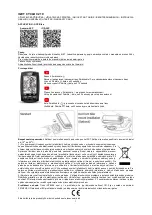
8
PW6C... Single point load cells
HBM
A2424-1.0 en/de/fr
2.1 Connecting in four-wire and six-wire configurations
When load cells calibrated in a six-wire configuration are connected to
amplifiers with a four-wire configuration, the sense leads of the load cells must
be connected to the corresponding excitation leads.
When connecting load cells calibrated in a four-wire configuration to amplifiers
in a six-wire configuration, a relevant bridge must be attached in the amplifier
input between the sense lead and the excitation lead.
4-wire cable connection (cable length: 0.35 m)
3
4
Contact 2 (white) = Signal (+)
Contact 1 (blue) = Excitation (+)
Contact 3 (red) = Signal (−)
Contact 4 (black) = Excitation (−)
Shield (yellow) = cable shield
connected to load cell body
Schematic diagram of a Pancon connector (CE100F26-4), 4-pin
1
2
blue marking
Option: 6-wire cable connection (a choice of lengths: 0.35, 1.5 m; 3 m; 6 m)
4
Contact 1 (white) = Signal (+)
Contact 3 (black) = Excitation (−)
Contact 6 (gray) = Sense (−)
Contact 4 (blue) = Excitation (+)
Contact 5 (green) = Sense +)
Contact 2 (red) = Signal (−)
Shield (yellow) = cable shield
connected to load cell body
Schematic diagram of a Pancon connector (CE100F26-6), 6-pin
1
2
3
5
6
blue marking
2.2 Cable extensions
You must only use shielded, low-capacitance measurement cables to extend
the cables, making sure that there is a proper connection with minimal contact
resistance.
The cable of a six-wire load cell can be extended with a cable of the same type.
The cable of a four-wire load cell should be extended with a 6-wire cable. At
the connecting point between the the 4-wire and 6-wire cables, the excitation
leads must be connected to the relevant sense lead.









































